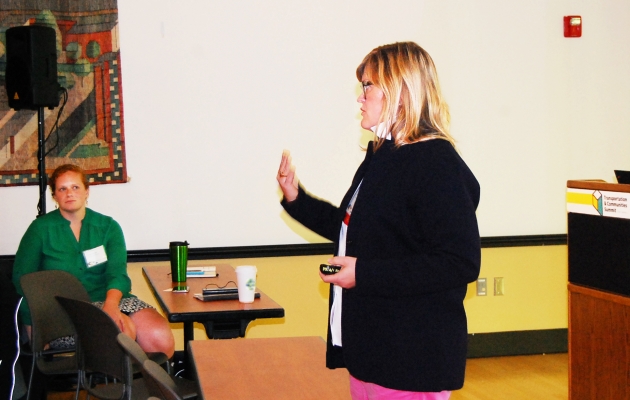City uses TREC research to better set development fees

The city of Portland is using research and expertise from TREC researchers to change how it calculates fees for new development. Developers pay the fees, called transportation system development charges, to offset some of the costs of providing transportation infrastructure.
The foundation for those fees has been cars: that is, how many car trips a development will generate. In December, the Portland City Council voted to instead use “person trips” as the basis for those fees.
Researchers Kelly Clifton and Kristina Currans have assembled an impressive portfolio of research projects on trip generation. Their research caught the attention of city officials, who brought Clifton and Currans in as consultants to help them rethink the way they assess new fees for development.
Their work found a receptive audience of practitioners at TREC’s flagship conference, the Transportation and Communities Summit, last fall. Clifton and Currans held a workshop on improving trip generation methods to better represent the mix of modes found in livable communities. That led to a collaboration with transportation consultants Fehr and Peers and an invitation to present to City Council last December.
After Clifton’s presentation, the City Council voted to base their method for assessing fees on person-trips—starting with people first and then considering the modes they take—instead of automobile trips. That’s an important first step, Clifton said, although the exact methodology used in the assessment is still being developed.
Using person-trips lets city officials support the mix of transportation modes they want for each neighborhood, Clifton said. “We’re not going to presume what the mode will be; we’re going to plan for the desired mode shares reflected in plans and policies."
“Instead of saying ‘this many cars come here,’ we say ‘how many people come here and how do we support the mode share?’”
The focus on person trips also aligns with other planning tools, such as Metro’s regional travel demand model. This allows planners to examine trips at the site level, the neighborhood level and across the region.
“It lets us have that consistency,” Clifton said. “They’re using the same basic units so the planning tools can talk to each other.”
As modes such as autonomous vehicles arrive, the new methodology will give the city more flexibility to adjust and add new modes. It also allows for a more accurate picture of the effect different modes have on the transportation system.
Christine Leon, development permitting and transit manager for the Portland Bureau of Transportation, said this approach makes sure the city is counting what matters. “We want to count people, not cars, to be able to quantify development impacts and make sure they pay their fair share, no more and no less,” Leon said.
The transportation system serves people using a variety of modes, Leon said, and projects on the city’s list for funding from development charges are largely multimodal bicycle, pedestrian and transit projects. “The growth of our transportation system cannot only be fed by cars,” she said.
Leon met Clifton at the previous Transportation and Communities Summit, in 2015, and attended her workshop at last fall’s summit as well. That connection has proved valuable in allowing Portland use the best new research to align its policies with its values, Leon said.
“When I explain to city commissioners or Portland constituents why PBOT is taking a new approach on trips generated by development—because the science hasn’t completely caught up with us yet—I say it’s because of our unique relationship with TREC and PSU and the leadership that TREC is providing in this area.”
Information on Portland's transportation system development charges, including the new updates and proposed project list, are on the TSDC page.
